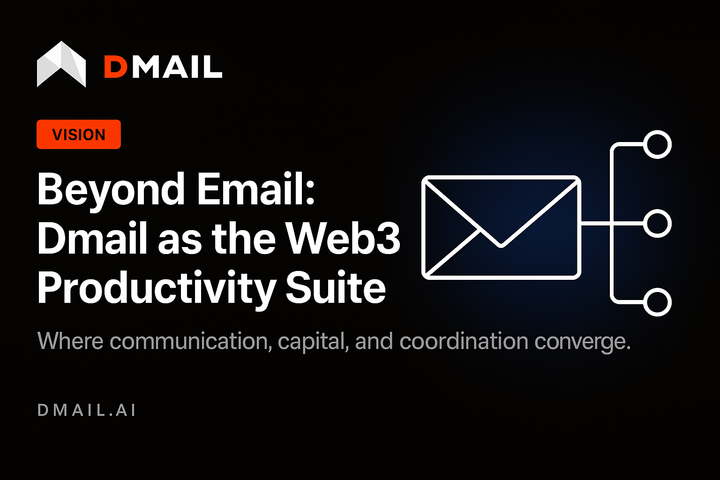How DMAIL builds the next-generation communication layer for Web3
DMAIL’s edge lies in composition, not ideology—taking the proven components and binding them with real economics, scalable architecture, and end-to-end privacy.

Rethinking communication infrastructure
In Web3, “messaging” isn’t just about chat. It’s about coordination—between users, protocols, and assets. Every message can trigger value transfer, automate logic, or anchor identity. But to get there, the infrastructure must be decentralized, private, and scalable.
The first wave of attempts—Whisper, IPFS PubSub hacks, and early P2P layers—proved the concept but not the economics. Today, the challenge is no longer if peer-to-peer communication can work; it’s how to make it fast, private, and production-grade.
This is where libp2p, Whisper, and their modern descendants enter the picture—and where DMAIL’s own architecture draws its advantage.
Whisper: the pioneer that burned bright and died fast
Ethereum’s original Whisper protocol deserves credit as the first serious attempt at decentralized private messaging. Its model was elegant: encrypted payloads gossiped across a P2P mesh, with no central coordination and no metadata leakage.
But it fell on the sword of its own purity. Flood-style gossip meant exponential bandwidth usage. Every node saw nearly every message. Resource requirements exploded, spam protection was non-existent, and the system simply couldn’t scale to millions of users.
Whisper proved privacy at the cost of practicality. It remains a valuable historical experiment, but it’s now effectively deprecated.
libp2p: the network substrate, not the product
libp2p emerged from the IPFS ecosystem to solve a different problem: networking abstraction. It provides the transport, multiplexing, peer discovery, and pub/sub plumbing—but deliberately avoids dictating how messages are stored, routed, or filtered.
In other words, libp2p gives you the pipes, not the water.
This makes it ideal for composable architectures. You can choose TCP, QUIC, or WebRTC; layer gossipsub on top; implement your own relay logic; and bolt on encryption schemes suited to your threat model.
DMAIL adopts libp2p as its transport foundation because it delivers what matters most—modularity, stability, and battle-tested connectivity across browsers, mobile devices, and nodes.
Waku v2: Whisper reborn for the real world
Waku, developed by the Vac/Status team, is effectively Whisper re-engineered for scale. It keeps the decentralized privacy model but divides the workload into distinct roles:
- Relay nodes handle live message gossip.
- Store nodes manage message history and retrieval.
- Filter nodes allow light clients to subscribe only to relevant topics.
This architecture transforms the old flood-and-hope model into something mobile-friendly, bandwidth-efficient, and resistant to spam. Add rate-limiting, relay scoring, and proof-of-work or stake-based anti-abuse, and you get a usable base layer for production environments.
Waku is the current benchmark for decentralized, wallet-based communication. But it’s still a protocol, not a product. That’s where DMAIL diverges.
DMAIL’s hybrid stack: pragmatic decentralization
DMAIL builds on these lessons but refuses to inherit any single protocol’s limitations. Its messaging stack deliberately combines components:
- Transport layer: libp2p for flexible, multi-transport networking.
- Message layer: Waku-style relay/store/filter system with topic scoping and client-side indexing.
- Encryption layer: HPKE/Noise-based envelopes with per-thread rotating keys for forward secrecy.
- Economic layer: Proof-of-work or micro-fee stamps that make spam expensive and legitimate communication cheap.
- Storage layer: Content-addressed data, encrypted client-side, retrievable through decentralized store nodes.
- Identity layer: Wallets as primary IDs, with optional ENS/UD mapping and rotating sub-keys to minimize linkability.
The result is a system that can handle the trade-offs that broke previous designs: scalability without surveillance, privacy without isolation, and delivery without central servers.
Comparative snapshot
| Protocol | Strengths | Weaknesses | Verdict |
|---|---|---|---|
| Whisper | Strong privacy | Unscalable; deprecated | Historically important |
| libp2p | Modular networking substrate | Requires custom messaging logic | Excellent foundation |
| Waku v2 | Scalable, mobile-friendly, privacy-aware | Complex incentive design | Best modern base layer |
| Matrix/MLS | Mature enterprise-grade E2E | Federation overhead | Better for organizations than wallets |
| Nostr | Simple, open, viral growth | Weak privacy, spam-prone | Great for social, not secure comms |
| XMTP | Wallet-first developer UX | Centralized relays | Convenient, not sovereign |
DMAIL’s hybrid model extracts the strongest attributes of each: libp2p’s modularity, Waku’s scalability, Whisper’s privacy, and XMTP’s wallet integration—without their structural weaknesses.
The operational reality
Running a global, permissionless communication network means dealing with ugly problems: Sybil attacks, traffic analysis, spam bursts, and compliance boundaries. DMAIL’s approach is not ideological—it’s operational.
- Anti-spam economics: small proof-of-work or fee stamps to throttle abuse.
- Peer scoring: relays are ranked and rotated by behavior.
- Selective retention: store nodes keep messages briefly unless users pin them via encrypted storage.
- Jurisdictional pinning: allows legal compliance without breaking decentralization.
Decentralization isn’t an excuse for chaos. It’s an architecture for accountability without control.
The next step: programmable communication
Once you have secure, scalable wallet-based messaging, you can fuse communication and value transfer. Messages trigger smart contracts. Subscriptions pay out in tokens. NFTs become message carriers. The inbox becomes a programmable interface for decentralized coordination.
That’s DMAIL’s long-term thesis: messaging as middleware for the on-chain economy.
Closing thoughts
Whisper died of idealism. libp2p thrives on modularity. Waku rebalanced the trade-offs.
DMAIL’s edge lies in composition, not ideology—taking the proven components and binding them with real economics, scalable architecture, and end-to-end privacy.
That’s how decentralized messaging evolves from a proof of concept into a communication layer ready for the next billion users.

Connect with Dmail: Website | Twitter | Discord | Github | Telegram





Comments ()